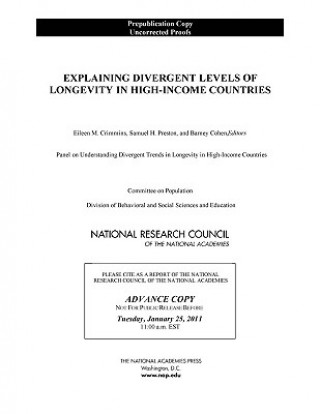
Kód: 04579207
Explaining Divergent Levels of Longevity in High-Income Countries
Autor National Research Council, Panel on Understanding Divergent Trends in Longevity in High-Income Countries, Committee on Population, Division of Behavio
During the last 25 years, life expectancy at age 50 in the United States has been rising, but at a slower pace than in many other high-income countries, such as Japan and Australia. This difference is particularly notable given th ... celý popis
- Jazyk:
 Angličtina
Angličtina - Vazba: Brožovaná
- Počet stran: 194
Nakladatelství: National Academies Press, 2011
- Více informací o knize

1219 Kč
Dostupnost:
50 % šance Máme informaci, že by titul mohl být dostupný. Na základě vaší objednávky se ho pokusíme do 6 týdnů zajistit.
Máme informaci, že by titul mohl být dostupný. Na základě vaší objednávky se ho pokusíme do 6 týdnů zajistit.Prohledáme celý svět
Mohlo by se vám také líbit
-

Essential Primary English
1087 Kč -

Four: A Divergent Collection
443 Kč -

Divergent Collector's edition
559 Kč -

Christmas Around the World Coloring Book
105 Kč -

Ethical Issues in Six Religious Traditions
1036 Kč -

Cat
5656 Kč -

Divergent
250 Kč
Dárkový poukaz: Radost zaručena
- Darujte poukaz v libovolné hodnotě a my se postaráme o zbytek.
- Poukaz se vztahuje na celou naši nabídku.
- Elektronický poukaz vytisknete z e-mailu a můžete ihned darovat.
- Platnost poukazu je 12 měsíců od data vystavení.
Informovat o naskladnění knihy
Zadejte do formuláře e-mailovou adresu a jakmile knihu naskladníme, zašleme vám o tom zprávu. Pohlídáme vše za vás.
Více informací o knize Explaining Divergent Levels of Longevity in High-Income Countries
Nákupem získáte 122 bodů
 Anotace knihy
Anotace knihy
During the last 25 years, life expectancy at age 50 in the United States has been rising, but at a slower pace than in many other high-income countries, such as Japan and Australia. This difference is particularly notable given that the United States spends more on health care than any other nation. Concerned about this divergence, the National Institute on Aging asked the National Research Council to examine evidence on its possible causes. According to Explaining Divergent Levels of Longevity in High-Income Countries, the nation's history of heavy smoking is a major reason why lifespans in the United States fall short of those in many other high-income nations. Evidence suggests that current obesity levels play a substantial part as well. The book reports that lack of universal access to health care in the U.S. also has increased mortality and reduced life expectancy, though this is a less significant factor for those over age 65 because of Medicare access. For the main causes of death at older ages -- cancer and cardiovascular disease -- available indicators do not suggest that the U.S. health care system is failing to prevent deaths that would be averted elsewhere. In fact, cancer detection and survival appear to be better in the U.S. than in most other high-income nations, and survival rates following a heart attack also are favorable. Explaining Divergent Levels of Longevity in High-Income Countries identifies many gaps in research. For instance, while lung cancer deaths are a reliable marker of the damage from smoking, no clear-cut marker exists for obesity, physical inactivity, social integration, or other risks considered in this book. Moreover, evaluation of these risk factors is based on observational studies, which -- unlike randomized controlled trials -- are subject to many biases.
 Parametry knihy
Parametry knihy
Zařazení knihy Knihy v angličtině Society & social sciences Sociology & anthropology Sociology
1219 Kč
- Plný název: Explaining Divergent Levels of Longevity in High-Income Countries
- Autor: National Research Council, Panel on Understanding Divergent Trends in Longevity in High-Income Countries, Committee on Population, Division of Behavio
- Jazyk:
 Angličtina
Angličtina - Vazba: Brožovaná
- Počet stran: 194
- EAN: 9780309186407
- ISBN: 0309186404
- ID: 04579207
- Nakladatelství: National Academies Press
- Hmotnost: 431 g
- Rozměry: 229 × 152 × 13 mm
- Datum vydání: 27. July 2011
Oblíbené z jiného soudku
-

Sex at Dawn
330 Kč -

Death and the Afterlife
454 Kč -

Cartoon Guide to Statistics
466 Kč -

Why Love Hurts - A Sociological Explanation
438 Kč -

Past Mortems
250 Kč -

Basic and Advanced Focus Groups
1076 Kč -

Fair Play Deck
505 Kč -

Intimate Communion
326 Kč -

Tragedy and Hope
1126 Kč -

Small Is Beautiful
276 Kč -

More Than Two
603 Kč -

Regretting Motherhood
350 Kč -

Social Intelligence
378 Kč -

True Believer
353 Kč -

Art of Community: Seven Principles for Belonging
485 Kč -

NINETY PERCENT OF EVERYTHING
403 Kč -

Reassembling the Social
1056 Kč -

Family and Civilization
538 Kč -

Book of Tea
250 Kč -

Building and Dwelling
433 Kč -

Constructing Grounded Theory
1322 Kč -

Surrendered Wife
276 Kč -

Of Woman Born
376 Kč -

Cruel Optimism
782 Kč -

Death and the Afterlife
914 Kč -

What Kinship Is-And Is Not
481 Kč -

Social History of Sexual Relations in Iran
1396 Kč -

Post-Adoption Blues
446 Kč -

Dissecting the Danchi
3611 Kč -

Birth Of A Mother
556 Kč -

New Old Fashioned Ways
470 Kč -

Secret Meaning of Money - How to Prevent Financial Problems from Destroying Our Most Intimate Relationships
963 Kč -

Death Tourism
1006 Kč -

Platform Society
1004 Kč -

Braving the Wilderness
247 Kč -

Eroticism
303 Kč -

Marriage, a History
465 Kč -

Bushido the Soul of Japan
289 Kč -

Intercourse
384 Kč -

Ideology and Utopia
462 Kč -

Population Control
357 Kč -

Class Ceiling
367 Kč -

Chrysanthemum and the Sword
437 Kč -

Smoke Gets in Your Eyes
302 Kč -

Sociology: A Very Short Introduction
250 Kč -

Being Mortal
323 Kč -

Theory of the Leisure Class
303 Kč -

Social Construction of Reality
303 Kč -

Bushido: The Soul Of Japan
435 Kč
Osobní odběr Praha, Brno a 12903 dalších
Copyright ©2008-24 nejlevnejsi-knihy.cz Všechna práva vyhrazenaSoukromíCookies


 Vrácení do měsíce
Vrácení do měsíce 571 999 099 (8-15.30h)
571 999 099 (8-15.30h)